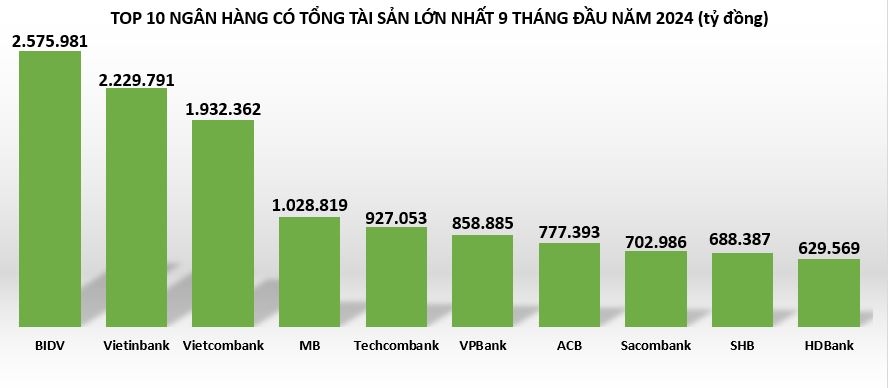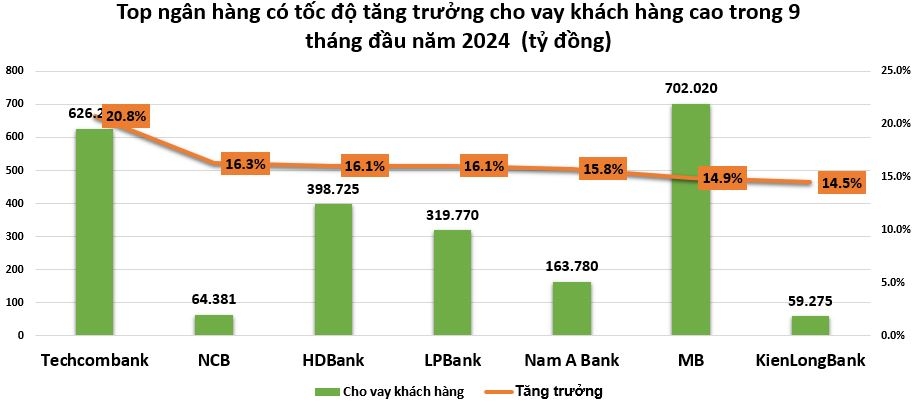Tài sản và dư nợ cho vay tại loạt ngân

![]()
Ngân hàng nào có tốc độ tăng trưởng tổng tài sản nhanh nhất?
Theo thống kê từ báo cáo tài chính quý III/2024 của 29 ngân hàng đã công bố (không bao gồm Agribank), tổng tài sản của các ngân hàng này tính đến 30/9/2024 đạt hơn 16,2 triệu tỷ đồng, tăng 8,6% so với đầu năm. Trong đó, tổng tài sản của 10 ngân hàng dẫn đầu lên tới hơn 12,3 triệu tỷ đồng, chiếm 76%.
Hiện BIDV tiếp tục duy trì vị trí quán quân về tổng tài sản với 2,57 triệu tỷ đồng, tăng 12% so với đầu năm. Sau 9 tháng, dư nợ tín dụng của BIDV đã tăng trưởng 9,8% so với đầu năm, đạt 1,96 triệu tỷ đồng. Đây là lần tiên trong lịch sử, hệ thống ngân hàng Việt Nam ghi nhận một ngân hàng có tổng tài sản vượt mốc 100 tỷ USD.
Á quân thuộc về Vietinbank với gần 2,23 triệu tỷ đồng tài sản, tăng gần 10%. Tổng tài sản của Vietcombank sau 9 tháng đầu năm tăng 5% với 1,93 triệu tỷ đồng, xếp ở hạng ba.
Đối với nhóm ngân hàng tư nhân, trong 9 tháng đầu năm, MB tiếp tục dẫn đầu và chính thức ghi tên mình vào danh sách các ngân hàng có tổng tài sản vượt mức 1 triệu tỷ đồng, tăng gần 9% so với đầu năm.
Xếp sau MB là Techcombank (927.053 tỷ đồng), VPBank (858.885 tỷ đồng), ACB (777.393 tỷ đồng), Sacombank, SHB (hơn 688.000 tỷ đồng) và HDBank (629.569 tỷ đồng).
 |
Đặc biệt, dù không nằm trong Top 10 ngân hàng có tổng tài sản lớn nhất, song trong 9 tháng đầu năm 2024, LPBank, BVBank, NCB lại là những ngân hàng có tốc độ tăng trưởng tổng tài sản cao nhất.
Cụ thể, tính đến 30/9/2024, tổng tài sản tại LPBank tăng 19% so với đầu năm, đạt hơn 455.800 tỷ đồng; tiếp đến là BVBank tăng 13% đạt hơn 99.400 ty đồng và NCB cũng tăng 13% lên hơn 108.850 tỷ đồng.
Như vậy, BIDV tiếp tục là quán quân về tổng tài sản với hơn 2,57 triệu tỷ đồng, tăng khoảng 12%. MB là ngân hàng dẫn đầu trong nhóm thương mại cổ phần. LPBank đang là ngân hàng có tốc độ tăng trưởng tổng tài sản cao nhất trong ba quý đầu năm.
Nhà băng nào đang ‘mạnh tay’ cho vay nhất?
Theo số liệu Ngân hàng Nhà nước (NHNN), tính đến cuối tháng 9, dư nợ tín dụng nền kinh tế đạt khoảng 14,8 triệu tỷ đồng, tăng 9% so với cuối năm ngoái. Phần lớn dư nợ tăng thêm trong ba quý đầu năm thuộc về nhóm các ngân hàng đang niêm yết.
Tương tự như tổng tài sản, hiện BIDV tiếp tục là quán quân về cho vay khách hàng với quy mô hơn 1,95 triệu tỷ đồng, tăng 9,9% so với đầu năm. VietinBank đứng vị trí thứ hai trong danh sách, với dư nợ ở mức 1,61 triệu tỷ đồng, tăng 9% so với đầu năm. Xếp thứ ba là Vietcombank, với tổng dư nợ cho vay đạt 1,4 triệu tỷ đồng, tăng 10,3%.
Đối với nhóm ngân hàng tư nhân, MB và VPBank là hai ngân hàng có quy mô cho vay khách hàng cao nhất lần lượt đạt 702.020 tỷ đồng và 635.345 tỷ đồng, tăng 14,9% và 12,2% so với đầu năm.
Techcombank cho vay hơn 626.000 tỷ đồng, tăng trưởng 20,8% so với đầu năm. Ngân hàng ACB cho vay 545.333 tỷ đồng, tăng 13,3%. Sacombank cho vay 513.690 tỷ đồng, tăng 8,8%. SHB cho vay 467.468 tỷ đồng, tăng 10%. Ngân hàng cuối cùng trong Top 10 là HDBank với 381.463 tỷ đồng dư nợ cho vay, tăng mạnh 16%.
Đáng chú ý, tuy không nằm trong Top 10 ngân hàng cho vay khách hàng nhiều nhất 9 tháng năm 2024, song LPBank, Nam A Bank, NCB, KienLongBank, TPBank,… lại ghi nhận mức tăng trưởng cho vay cao.
 |
Cụ thể, tính đến 30/9/2024, dư nợ cho vay khách hàng tại NCB tăng 16,3% so với đầu năm, đạt 64.382 tỷ đồng; LPBank tăng 16% đạt hơn 398.700 tỷ đồng; Nam A Bank tăng 15,8% đạt hơn 163.700 tỷ đồng; MSB tăng 14,4% đạt hơn 170.620 tỷ đồng; KienLongBank tăng 14,5% đạt hơn 59.000 tỷ đồng; TPBank tăng 14,4% đạt hơn 234.720 tỷ đồng.
Như vậy, dẫn đầu về mức tăng trưởng tín dụng 3 quý đầu năm gồm có Techcombank (20,8%); NCB (16,3%); HDBank và LPBank (16,1%); Nam A Bank (15,8%).
Có thể thấy, BIDV đang dẫn đầu về quy mô cho vay khách hàng tại nhóm ngân hàng quốc doanh còn MB là quán quân của nhóm cổ phần. Trong khi đó, Techcombank đang là ngân hàng có tốc độ tăng trưởng cho vay khách hàng cao nhất trong ba quý đầu năm.
Lê Thanh
Theo tudonghoangaynay.vn Copy







